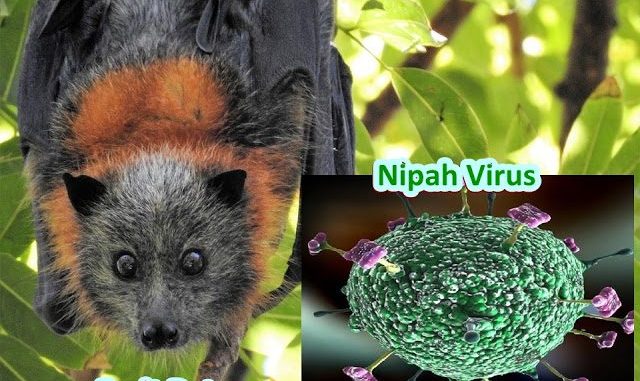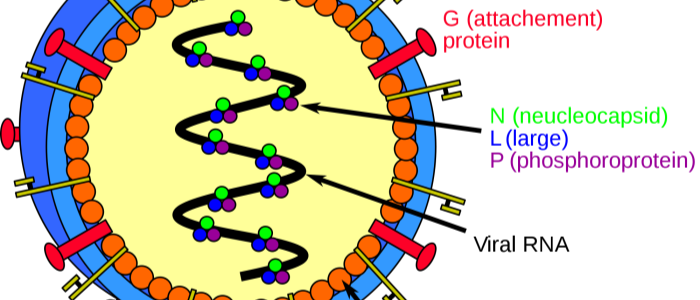
Nipah virus: Structure and genome, mode of transmission, Pathogenesis, Symptoms, prevention and treatment
Structure and genome of Nipah virus:
- Nipah virus ( NiV) is a RNA virus belongs to family Paramyxoviradae and genus Henipavirus.
- Size: 40-600nm
- Shape: pleuromorphic
- Envelope: present

Genome and proteins of Nipah virus:
- Single stranded negative sense RNA, 18246 bp (Malaysian isolate) and 18252 bp (bngladesh isolate)
- Genome has six transcriptional unit that six structural proteins. They are nucleocapsid (N), phosphoprotein (P), matrix protein (M), fusion protein (F), glycoprotein (G) and polymerase (L)
- Protein associated with genome: large (L) protein, phospoprotein (P)
- Viral proteins: fusion protein (F) and attachment glycoprotein protein (G)
- Phosphoprotein (P): it role as a polymerase cofactor, enhancing polymerase processivity and allowing the encapsidation of the newly synthesized viral genomes and antigenomes.
- Phosphorotein of Nipah virus has an additional role in immunosuppression: blocking interferon signaling by binding host STAT-1.
Mode of transmission of Nipah virus:
- Nipah virus is a zoonotic virus.
- Flying fox (family Pteropodidae and particularly species of genus Pteropus ) are the natural host for Nipah virus.
- Direct contact: Human get infection by direct contact with infected animals (pigs and fruit bats) or human
- Droplet infection: respiratory droplets, nasal or throat secretion of infected animals
- Eating contaminated fruits and juices with body secretion of infected animals
- Human to human transmission with direct contact with infected person
Pathogenesis and pathology of Nipah virus:
- Human get infected with Nipah virus by direct contact with the body secretion of infected animals or by ingestion of contaminated food products.
- Fruit bats of family Pteropodidae are the natural host and reservoir of Nipah virus, while they remain uninfected.
- Infected fruit bats sheds virus in their urine or body secretion with infects pigs as well as other domesticated animals.
- Domesticated animals especially pigs are the intermediate host for Nipah virus and human get infection by direct contact with these animals.
- Human infection is also reported by consumption of contaminated fruits or date palm saps.
- Incubation periods in infected pig ranges from 4-14 days. Infected pigs may develops symptoms such as acute respiratory and neurological illness.
- Nipah virus are belived to infect respiratory tract epithelial tissue resulting is shedding of epithelial lining along with nasopharyngeal secretion.
- Patients develops symptomatic respiratory infection in early stage of infection.
- During late stage, virus spread to lungs endothelium resulting in endothelial syncytium and mural necrosis. Nipah virus can then enter the bloodstream and disseminate throughout the host in either free form or by binding host leukocytes. (Nipah virus has been shown to bind to CD3+ leukocytes without entry or replication of the virus)
- Other target organ of Nipah virus the brain, spleen and kidneys.
- Entry of Nipah virus into the CNS is thought to occur through two distinct pathways: anterogradely via the olfactory nerve and/or via the hematogenous route through the choroid plexus and cerebral blood vessels.
- Infection of the CNS in humans is characterized by vasculitis, thrombosis, parenchymal necrosis, and presence of viral inclusion bodies.
Clinical symptoms of Nipah virus infection:
- Clinical illness in human ranges from Asymptomatic to acute or sever symptomatic to fatal encephalitis
- Initially patients develops Influenza like symptoms such as; Fever, Sore throat, Headaches, Vomiting and Myalgia or Muscle pain
- Acute respiratory infection; Difficult in breathing.
- Some patients develop Atypical pneumonia
- Neurological illness results in encephalitis and seizures.
- Case fatility rate ranges from 43% to 100% in sporadic cases.
- Patients surviving acute encephalitis have been reported to show long term neurological conditions such as personality change and seizures.
Lab diagnosis of Nipah virus infection:
- Non-specific diagnosis by sign and symptoms
- Samples: nasal secretion, blood, contaminated fruits or infected animals
- RT-PCR
- ELISA
- Virus culture
Prevention and control of Nipah virus infection:
- Aware and educate people to take preventive measure to reduce contact with virus
- Apply preventive measure to sap collection such that bats cannot contaminate the collected sap.
- Boils the collected sap before consumption.
- Apply preventive measure while handling domesticated animals especially sick animals.
- Avoid direct or unprotected contact with infected person.
- Wear NH95-grade and higher masks
- Follow standard infection control procedure during handling patients and samples
Treatment and therapeutic measure of Nipah virus infection:
- Intensive supportive care
- No vaccine and No drugs
References:
- http://journals.plos.org/plosone/article?id=10.1371/journal.pone.0012709
- https://jidc.org/index.php/journal/article/view/23592639/857
- https://ac.elscdn.com/S0042682200903404/1s2.0S0042682200903404main.pdf?_tid=972b3087493b4c6e9e2a4757a4ab9bca&acdnat=1527346515_1876c33bf7defb4070f2472705b0dbed
- http://www.who.int/news-room/fact-sheets/detail/nipah-virus
